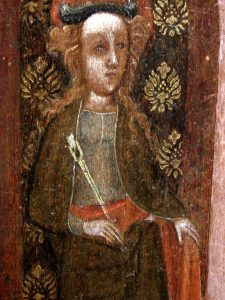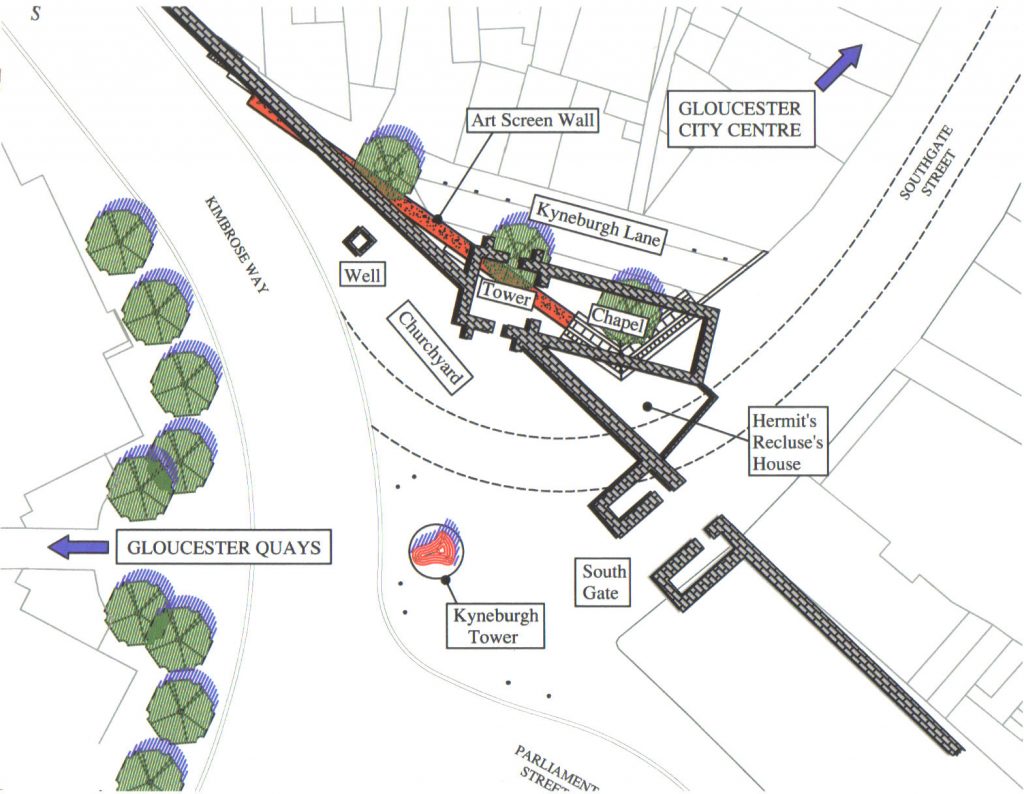 Last year I discussed the significance of specific medieval churches in my West Country medieval mystery series featuring my heroine, the Lady Apollonia of Aust. This year I want to speak of other church topics in my stories, beginning this quarter with saints.
Last year I discussed the significance of specific medieval churches in my West Country medieval mystery series featuring my heroine, the Lady Apollonia of Aust. This year I want to speak of other church topics in my stories, beginning this quarter with saints.
We will begin with Saint Apollonia because my heroine is named for this saintly woman who was martyred in Alexandia, Egypt, around 249 AD. She was tortured by having all her teeth smashed and, as a result, has become the patron saint of dentists and all who suffer tooth problems. I will leave it to you to read about Lady Apollonia’s birth in Effigy of the Cloven Hoof, so you will understand why the name of Apollonia was given to her as a baby. A picture in Exeter Cathedral of Saint Apollonia holding a tooth in a pair of tongs is shown on the left.
Several of my postings in earlier years dealt with specific saints: Saint Wulfstan on October 10, 2016; Saint Kyneburgh on April 14, 2017; Saint Raphael on June 6, 2017; and Saint Apollonia on November 18, 2022. You can read more about these saints by clicking on the archives for the appropriate month as listed below on the right.
Two of the saints in the previous paragraph were Anglo-Saxon saints. Kyneburgh was a local saint in Gloucester, the site of my third novel, Memento Mori. She was a Saxon princess who, fleeing from an arranged marriage, was adopted by a local baker. The jealous wife of the baker killed Kyneburgh, throwing her down a well, which led to miracles on that site.
Kyneburgh was venerated locally in Gloucester at the time of my story by the presence of a chapel in her name near that well which was close to the South Gate of the medieval city. There is a map shown above of that layout. Kyneburgh was especially revered by an anchorite whose cell was adjacent to that chapel. He dedicated his life to serving Saint Kyneburgh, and in that endeavor came to play an important role in the plot of Memento Mori.
Phil Moss is a local historian in Gloucester who was a great help to me with Gloucester history while I was writing Memento Mori. In 2011 he was commissioned by the City of Gloucester to draw a likeness of Saint Kyneburgh which you see on the right.
The other Anglo-Saxon saint cited above is Saint Wulfstan. He was one of several saints who had served as Bishop of Worcester, the site of my 6th novel, King Richard’s Sword. Appointed bishop in 1062, his bishopric survived the Norman Conquest, and he was the last Anglo-Saxon bishop still serving when he died in 1095. Although Worcester Cathedral was mostly Gothic by the time of Memento Mori in 1392, the chapter house and other monastic buildings were from the Norman Cathedral which Saint Wulfstan began. Indeed, the crypt under the church had been completed before his death.
 Other Englishmen who served as Bishop of Worcester are Saint Dunstan and Saint Oswald, both of whom lived in the 10th century, and each eventually served as an English archbishop, Dunstan at Canterbury and Oswald at York. They were active in founding and reforming monasteries. Saint Dunstan, earlier in his life, also served as Abbot of Glastonbury where my fifth book, Joseph of Arimathea’s Treasure, is set. He was canonized in 1029 and was the most popular English saint until Thomas Becket was canonized after his murder in Canterbury Cathedral.
Other Englishmen who served as Bishop of Worcester are Saint Dunstan and Saint Oswald, both of whom lived in the 10th century, and each eventually served as an English archbishop, Dunstan at Canterbury and Oswald at York. They were active in founding and reforming monasteries. Saint Dunstan, earlier in his life, also served as Abbot of Glastonbury where my fifth book, Joseph of Arimathea’s Treasure, is set. He was canonized in 1029 and was the most popular English saint until Thomas Becket was canonized after his murder in Canterbury Cathedral.
These saints would have been important to many of the characters in my medieval mystery stories. Throughout medieval England, saints were important to people’s everyday lives. Please check out my blog next time.
